Translation
On all the diagrams below, the 5' end
is at the left of the mRNA, the 3' end is at the right.

1. Initiation: The beggining of
the translation process.
To begin translation, the large (top) and small (bottom) ribosomal
units must be bound together to the strand of mRNA. This process is called initiation.
Initiation begins as rRNA polymerase on the ribosome binds the ribosomal units
to the mRNA. The ribosomes position themselves so that the codon sequence AUG
(the "start" codon) on the mRNA is exposed. A tRNA unit with the anticodon
sequence UAC bonds to the exposed "start" codon. This first tRNA only
carries the amino acid methionine (met) which is now set in place.
Initiation thus largely consists of placing this first tRNA and
its associated amino acid (met) in place on the mRNA.
(See Figure 15.13 in your book.)
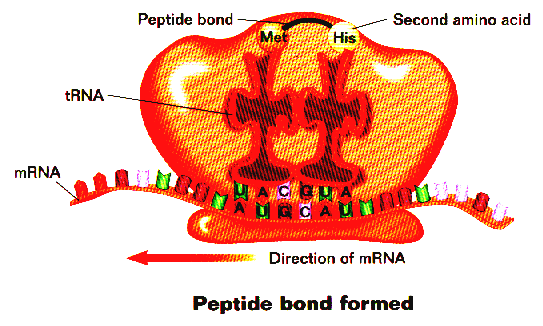
2. Elongation: It is the process where special
elongation proteins assist a new tRNA and its associated amino acid to bond
to the complementary codon on mRNA. Ultimately, this helps lengthen (elongate)
the polypeptide chain.
As the large ribosomal unit sets in place, the second codon on mRNA is exposed
(in this case, the codon is CAU). This exposed site is known as the A
site. At this point, a special protein unit known as the elongation factor
assists the 2nd tRNA to bond to this newly exposed codon. The GUA of the antidodon
(t RNA) bonds to the codon of CAU. At this point, the newly arrived amino acid
(his) is lined up next to the 1st amino acid (met). An enzyme binds both amino
acids via dehydration synthesis (loss of water) bonding.
(See Figure 15.15 in your book.)
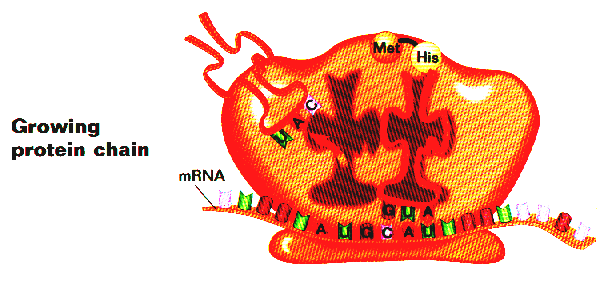
3. When the 1st two amino acids are bonded, the
first tRNA leaves the mRNA/ ribosomal complex.
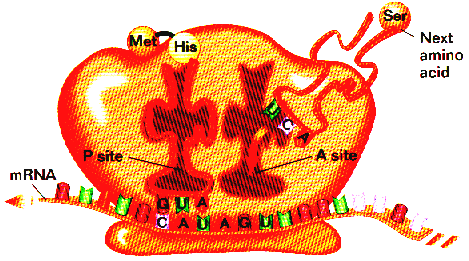
4. Translocation: In this step, the ribosomal
unit physically moves (translocates) 3 bases (a new codon: AUG) along the mRNA
in the 5' ---> 3' direction. When the new codon is exposed, another elongation
protein assists the new tRNA and its associated amino acid (Ser) to bind to
the codon. After this occurs, an enyme binds the amino acids His and Ser via
dehydration synthesis.
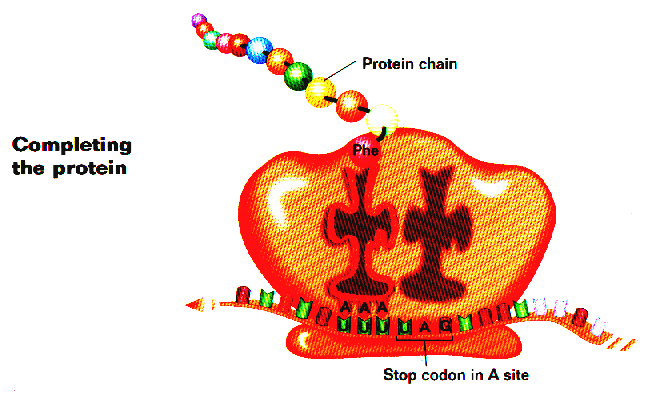
5. Termination: The end of the translation process.
The diagram above illustrates the ribosomal complex after it has been translocated
down the mRNA many codon sequences. The ribosome has constantly read the mRNA
in the 5' ---> 3' direction. The result is a growing chain of amino acids,
all bonded together to make a polypeptide chain.
When a codon with the nonsense sequence UAA,
UAG (seen here), or UGA is exposed, that is a signal that translocation is to
stop. The stop codon is not bonded to a complementary anticodon sequence on
a tRNA. Rather, a protein known as a release factor
binds at the A site. The release factor ultimately will help release the finished
polypeptide chain in the next step.
(See Figure 15.16 in your book.)
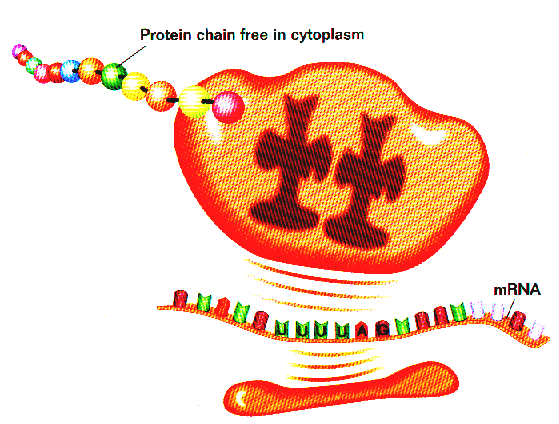
6. The release factor (not shown
in this diagram) prevents further reading of the mRNA message. The polypeptide
molecule is released from the ribosomal units. The mRNA and the large and small
ribosomal units are thus free to begin the translation process again.
Long & Slichter






